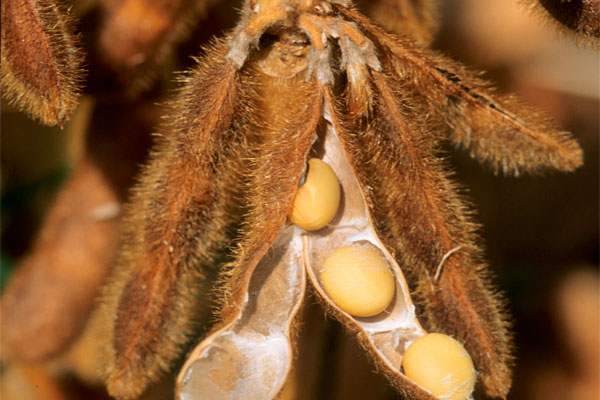Severe weather makes soybeans more susceptible to disease

Excessive rain during flowering and right after planting, coupled with cool nights, have caused an increase in some late season soybean diseases in many Ohio fields, according to a soybean expert from Ohio State University’s College of Food, Agricultural, and Environmental Sciences.
The extreme weather during these two key time periods in soybeans have made the plants really vulnerable to disease this year, said Anne Dorrance, an Ohio State University Extension plant pathologist who has led soybean disease research and outreach efforts in Ohio.
Dorrance, who also has an appointment with the Ohio Agricultural Research and Development Center, said now is the time growers should be scouting their fields to know what diseases may be impacting their soybean plants in order to know how to manage the fields to prevent similar occurrences next season.
OSU Extension and OARDC are the outreach and research arms, respectively, of the college.
“We’re seeing a lot of late season disease symptoms across the state,” Dorrance said. “While many of these diseases will spread, they are manageable.
“The key is to know where the pockets of diseases are. So it’s important to scout your fields to take a good, hard look at how things are going. Once you know what pathogens are in your field, then you can make better choices in variety selection and crop rotation, which are two key management elements.”
For example, Dorrance said, the occurrence of downy mildew in soybeans is higher than normal this year due to highly susceptible varieties and the heavy dews and cool nights the region has experienced in recent weeks.
Because this is occurring so late in the season, the impact on yields is thought to be minimal, she said, noting that there is no data available related to how well any management fungicides would work.
“The conditions could not be more perfect for this disease,” she said. “Downy mildew can infect seeds and if favorable conditions continue, the fungus can infect the pods and grow over the seed.”
The problem for soybean growers is that once a disease or organism is found in the soybean fields, it is there to stay, Dorrance said.
“Growers can manage disease through crop rotations, because many of these pathogens can live in soybean residue, so when we plant other crops like wheat and corn, most of the inoculum from those pathogens are decreased,” she said. “For example, soybean cyst nematode populations can be reduced by approximately 50 percent for every year growers rotate their crops.
“Another management option is to plant resistant varieties.”
Other diseases soybean growers need to be on the outlook for include:
- Sclerotinia — This fungus can cause white mold. Plants that are affected by this disease will soon be dying, and the condition may be seen from the edge of roads, Dorrance said. Affected plants have fluffy white growth on the bottom of the stems, and the seeds will not fill out on these plants. On some of the plants, the hard black sclerotia are forming, so these fields will get a fresh covering of sclerotia to serve as inoculum for the next few years, she said. Growers should monitor their fields, noting the variety planted. Growers who find that infections are above 20 percent should drop this variety from their lineup, Dorrance said. Growers should also harvest these fields after all of the other fields are harvested to prevent contaminating additional fields, she said.
- Sudden death syndrome — This is a root pathogen that is caused by a fungus, which produces a toxin that travels the stem and causes bright yellow and brown leaf discoloration. Growers should examine the stems to see if the symptoms their plants are exhibiting correspond to sudden death syndrome or if it is brown stem rot, Dorrance said. To determine this, growers can split the stems open and examine the pith. If it is chocolate brown, it is brown stem rot. If it is clear with blue spores on the tap root, it is sudden death syndrome, which in Ohio is more severe in fields with high soybean cyst nematode populations.
- Soybean rust — Although soybean rust hasn’t been detected in any fields in Ohio yet, the disease has been reported in Southern states as far north as Alabama, close to the Tennessee border, Dorrance said. The concern is that the disease could reach Ohio carried by storm fronts that move up from the south. If this occurs, it would impact those soybeans that are between flowering and R4 stages, in which pods are three-quarters of an inch long in one of four uppermost nodes on the main stem, she said.
Source: OSU Extension











